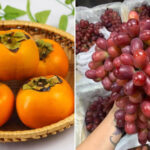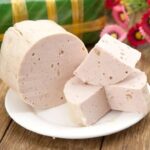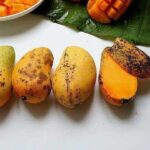How to Tell the Difference Between Naturally Ripened and Chemically Ripened Jackfruit
Look at the latex of the jackfruit
Naturally ripened jackfruits tend to have less latex and no white latex when cut open. On the other hand, jackfruits that have been injected with chemicals will often have white latex oozing from the flesh. This is a result of the injected substances.
Smell the jackfruit
The aroma of jackfruit is quite distinctive, especially when it’s naturally ripened. You should be able to smell the sweet fragrance from a distance. In contrast, chemically ripened jackfruits often lack this strong, alluring scent. Some may even be devoid of any noticeable fragrance, despite appearing ripe.
Examine the bulbs
Naturally ripened jackfruits typically have golden-hued bulbs with thick, creamy flesh. They offer a sweet and nutty taste. The fibers are usually pale yellow or white. On the other hand, forced-ripened jackfruits tend to feel starchy when eaten, and the fibers are a darker yellow, resembling the color of the bulbs.

Observe the spikes and eyes of the jackfruit
Naturally ripened jackfruits will have larger, softer spikes that are less pointed and more spaced out compared to when they were green. Pressing your finger into the fruit will reveal a soft texture. Conversely, jackfruits that have been forced to ripen through chemical injection tend to retain their sharp spikes, and the rind remains hard and thick.
Taste the jackfruit
If you’re buying pre-peeled jackfruit, taste a bulb to determine if it’s naturally ripened. Naturally ripened jackfruit bulbs offer a sweet and mild flavor, with a crisp yet tender texture. In contrast, forced-ripened jackfruit bulbs taste starchy and leave a strange aftertaste.
Tips for Choosing a Delicious Jackfruit
Even among naturally ripened jackfruits, some may be more delectable than others. Here are some tips to help you select the best one:
Listen to the sound
Gently tap the jackfruit with your hand. If it emits a hollow sound, it’s a good indication that the fruit is ripe and tasty.
Observe the shape
Choose a jackfruit that is uniformly round, without any noticeable indentations or narrow spots. Jackfruits with indentations or narrow spots are more likely to be infested with worms, resulting in a harder texture and increased fiber content.
Examine the spikes
Look for jackfruits with large, evenly spaced spikes. The spikes should not be overly long or pointed. Jackfruits with such characteristics tend to have more bulbs and a sweeter taste.
Feel the rind
Ripe jackfruits will have a softer rind. If the rind feels hard and the spikes are stiff, the fruit is likely unripe. For pre-peeled jackfruit, opt for bags with a bright golden color.
Check the stem
Different varieties of jackfruit have distinct characteristics when it comes to the stem. For example, the ideal length of the stem for a ‘Tố Nữ’ jackfruit is about 0.5 cm, while for a ‘Tây’ jackfruit, it’s between 1 and 1.5 cm.
According to Khoevadep
The Ultimate Guide to Choosing the Perfect Mango: Should You Pick the Ones With Black Spots for Worship on the Full Moon? Unveiling the Top 5 Tips From Growers to Get the Best Mangoes
To choose the perfect mangoes for your incense offering, one must possess an innate understanding of the fruit’s subtle nuances. It is an art, a delicate dance between the senses and the secrets whispered by the mangoes themselves. The quest for the ideal mango involves a discerning eye, a sensitive touch, and an unwavering devotion to the pursuit of aromatic excellence.



































